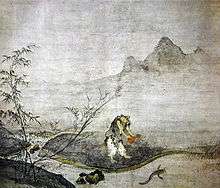Josetsu
Josetsu (如拙, fl. 1405–1496) was one of the first suiboku (ink wash) style Zen Japanese painters in the Muromachi Period (15th century). He was probably also a teacher of Tenshō Shūbun at the Shōkoku-ji monastery in Kyoto. A Chinese immigrant, he was naturalised in 1370 and is known as "the father of Japanese ink painting".

The best known of his paintings belongs to Taizō-in, a sub-temple of Myōshin-ji in Kyoto, which is entitled Catching a Catfish with a Gourd (c. 1413). It shows a comical-looking man fishing against a background of a winding river and a bamboo grove. It is thought to have been inspired by a riddle set by the Ashikaga shōgun, "How do you catch a catfish with a gourd?" It can be viewed as a piece of Zen humour, or as a kōan in visual form designed to provoke the viewer into new ways of "seeing". Josetsu was an amazing figure in ink painting at that period of time and also influenced many painters as well.
See also
References
- Terukazu, Akiyama (1961), "Chapter 6: The Renewed Influence of Chinese Art and the Development of Monochrome Painting (13th - 16th Century)", Japanese Painting, Treasures of Asia, archived from the original on 2005-03-09
- Chisholm, Hugh, ed. (1911). . Encyclopædia Britannica (11th ed.). Cambridge University Press. p. 174.
The initiation of the new movement is attributed to a priest named Jôsetsu, who lived in the early part of the 15th century, and of whom little else is known.